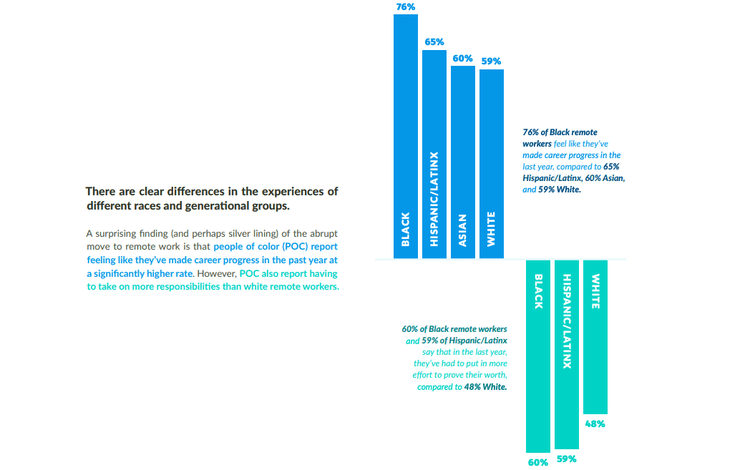4 Tips for Creating Effective Employee Resource Groups

How can you make sure you are creating an equitable opportunity for advancement for all your employees? One way might be to facilitate employee resource groups, or ERGs: groups that employees can voluntarily join to connect based on shared experiences and needs.
Our recent BambooHR survey, Career Progression and the COVID-19 Effect, revealed something compelling: While 76% of Black remote workers responded that they felt they’ve made career progress in the last year, as did 65% of Hispanic/Latinx employees and 60% of Asian employees, a majority of POC working remotely also said they felt they had to put in more effort to prove their worth, compared to only 48% of White employees.

Forming ERGs within your company can help identify and find solutions for situations like this, where a group of employees is feeling like expectations or growth opportunities are different for them. So, check out these four tips for creating effective employee resource groups so you can help create a more equitable workplace.
1. Be Thoughtful About Which ERGs You Create
You may be tempted to create an ERG for every perceived need at your company, but this likely won’t be effective, if it’s even feasible. “They’re not an end-all solution. At some point, for instance, there’s a scaling issue,” says Cassie Whitlock, director of HR at BambooHR, in an article for Fast Company. “A group can’t be formed for every possible delineation. What’s more, ERGs too narrowly defined can inadvertently exclude employees, creating the opposite of the desired effect.”
Instead, Cassie recommends utilizing ERGs to create balance, giving people with similar needs and experiences the opportunity to come together as one, while also providing resources to employees outside of ERGs to ensure they, too, feel heard and empowered.
Some common ERGs include:
- Mentors and mentees
- Working parents
- LGBTQ+ individuals and allies
- Mental health advocates
- Disability advocates
- Volunteers
- People of color
If you aren’t sure which groups would best suit your employees, keep an open ear and consider sourcing employee feedback.
Could an ERG for underrepresented employees, special interest, or shared identity truly benefit your employees and organization? That depends on:
- Creating a clear purpose for the group
- Finding a thoughtful way to align the ERG with your business needs
2. Set Clear Expectations
“Clearly defining an actionable purpose is crucial,” says Cassie. If you don’t set clear expectations for the purpose of the group from the start, how it can affect positive change, and what change is possible, you may end up creating a gripe group without direction or momentum instead of a support group that helps your employees grow within and alongside your company. Cassie recommends encouraging employees to and possibly helping them create a charter for the group that establishes an area of focus and sets an action plan for how employees can suggest changes and pitch to leaders.
3. Get Buy-In from Leadership
Groups won’t be able to effect change if they don’t have buy-in from the top. If employees aren’t being heard or supported, an ERG can quickly devolve into a hotbed for dissatisfaction and poor employee experience. Cassie suggests having an executive sponsor for each ERG you create: “ERGs support individual and company success and, as such, executive sponsors bring the ERG goals into business strategy meetings and discussions.”
An executive sponsor should be a dedicated resource and sounding board for the ERG leaders and members. Ideally, the executive sponsor should also champion the ERG’s cause and help them come up with changes and solutions that create a more equitable landscape for opportunity and growth at the company.
4. Select Well-Informed Group Leaders
In addition to an executive sponsor, each group should have a group leader who leads meetings, makes plans, upholds the charter, protects the space of its members, etc. This person should be knowledgeable and passionate about the ERG’s subject and a member of the select demographic, if applicable.They should also be accountable for the direction of the group and the community it serves.
Without a well-informed group leader, the purpose and momentum of the group can be lost. Cassie shares an example of what this can look like in real life: “With the best of intentions, [one group leader] began to stray from the original charter and use the group as a platform to discuss topics of personal interest. I was asked to step in and see if I could help the group rally and refocus. But by that time, participants had lost interest. They felt it wasn’t a priority for the business, which couldn’t have been farther from the truth. As with important business goals and initiatives, choosing a good leader and holding them accountable is important for ERG success.”
With more and more companies moving to a hybrid work model, it’s more essential than ever to ensure employees have spaces where they feel heard, supported and empowered within your organization. While they aren’t a complete or perfect solution, Employee Resource Groups can help you identify and understand employee needs, provide opportunities to resolve inequities, create a more inclusive space for your employees, and lift your whole organization to success.